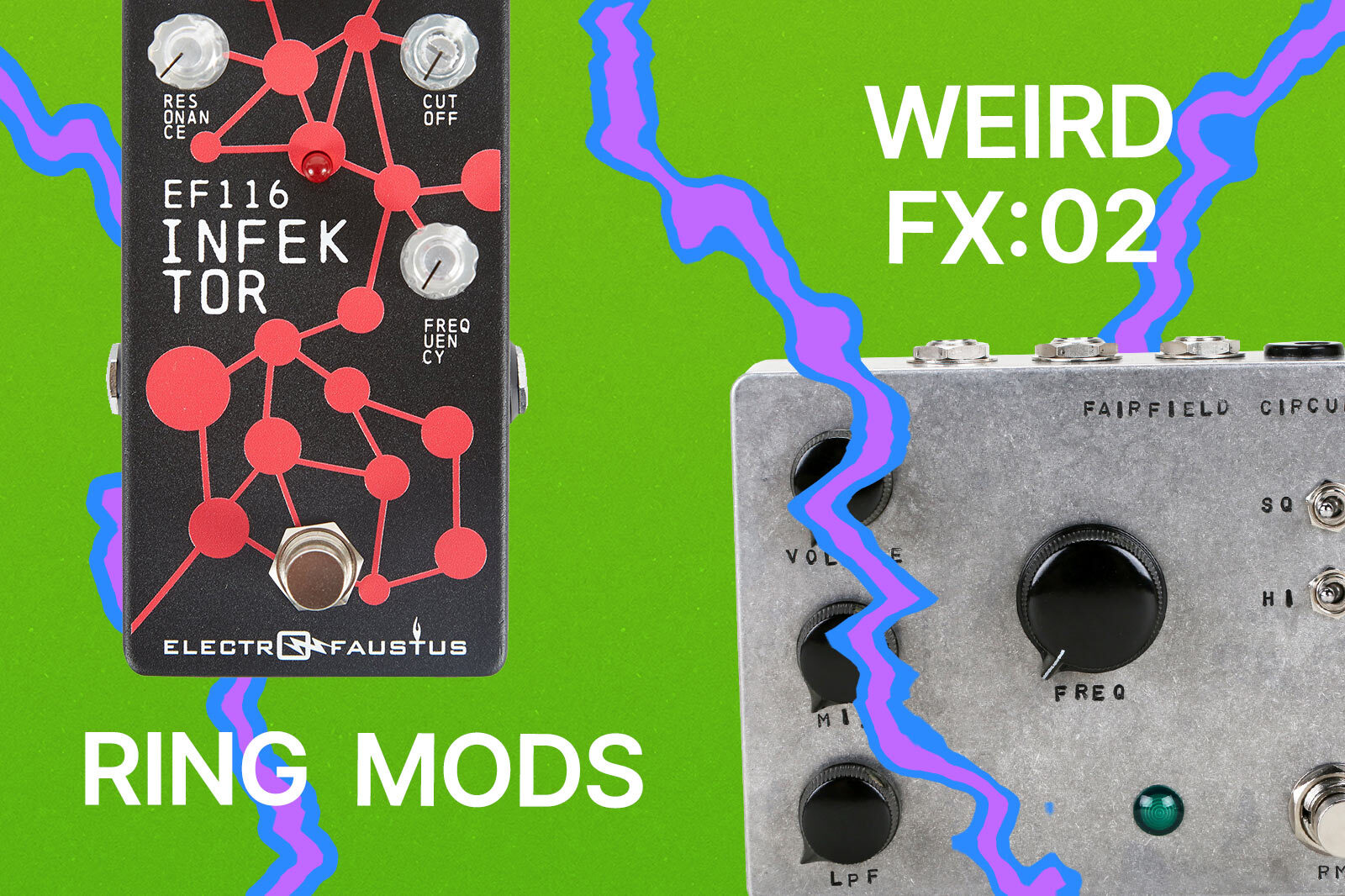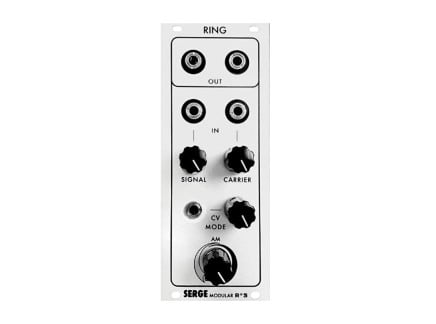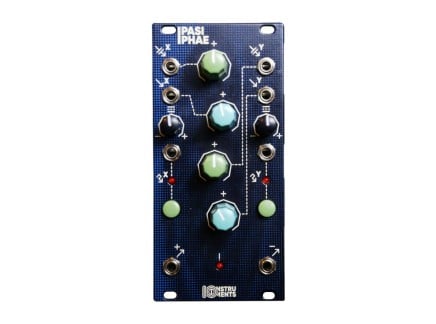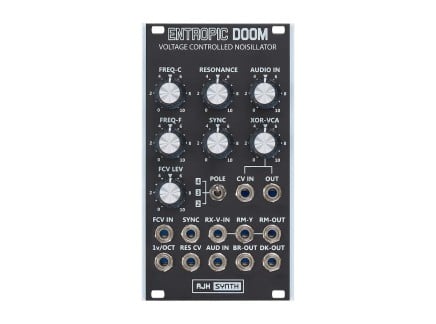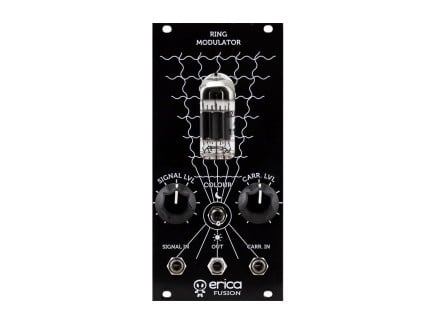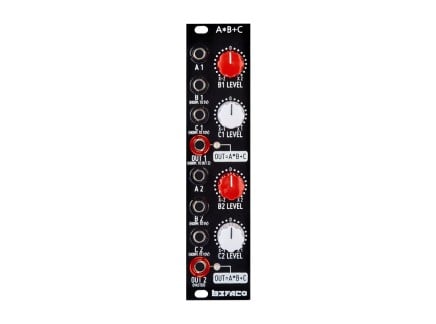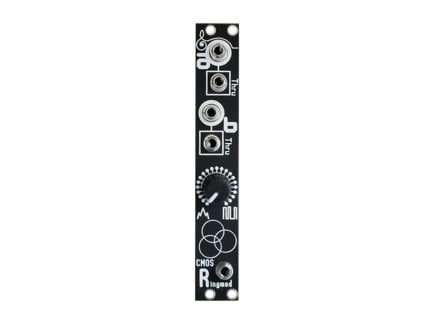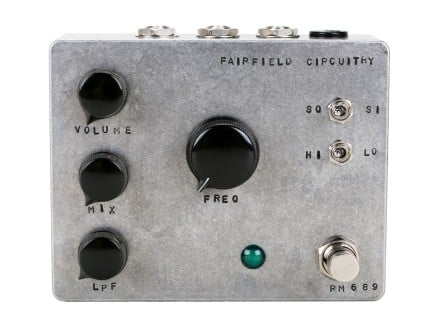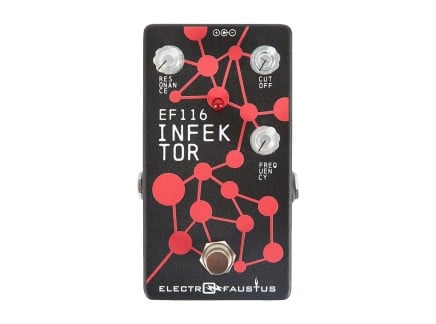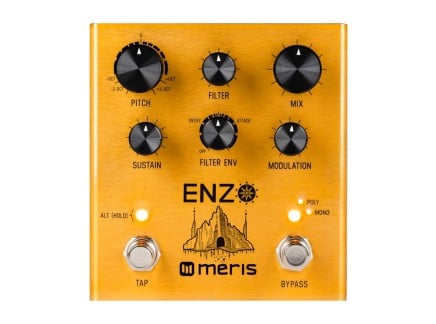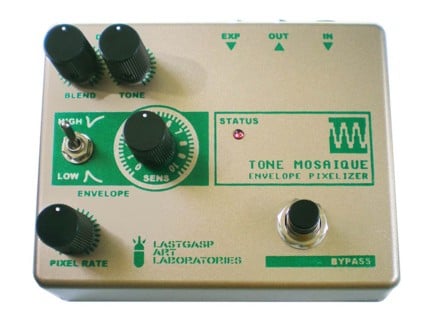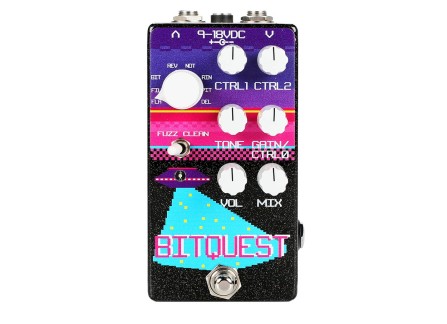Clang, crash, buzz, and robotic howls—ring modulators have given us everything from Dalek voices and Forbidden Planet soundscapes to abrasive Locust bass lines and ear-bending Mars Volta vocals. At first, the sounds of a ring modulator can be abrasive, jarring, or even (gasp!) "unmusical," but that doesn't mean they don't have their place: they can be the perfect thing for transforming simple sounds into something truly memorable, confounding, or even beautiful. While they might seem to most like novelty effects, there's good reason to make them part of your workflow.
One of the interesting truths about ring modulators is that they transcend many types of gear; many of us might think of them as being standalone, guitar stompbox-style effect processors, but they're also a relatively standard part of modular synthesizers and integrated keyboard synths as well. In this article, we'll cover a lot of ground, discussing ring modulation's history and technical implementation, and of course, we'll point out some of our favorite ring modulators in pedal and modular synth format, as well as some ways you can use them in your own music. Open your ears and buckle up!
So What Is a Ring Modulator?
Ring modulators provide a way to use two distinct audio signals to...well, mess up one another's timbre in fairly significant ways, often resulting in strongly inharmonic/dissonant sounds without a clear sense of pitch. In so many words, they take two incoming signal and produce the sum and difference frequencies of both of these sounds—effectively creating a dissonant pitch-shifting effect that simultaneously produces upward and downward pitch shifts. Unlike a conventional pitch shifter, though, the results are usually very different from the input: ring modulation alters a sound's harmonic profile in such a way that even very recognizable tones can be drastically transformed.
 Ring modulation diagram from Allen Strange's seminal text Electronic Music: Systems, Techniques, and Controls
Ring modulation diagram from Allen Strange's seminal text Electronic Music: Systems, Techniques, and Controls
Ring mods look fairly different in different contexts. Most pedal-format ring modulators offer a fairly minimal set of controls—usually only a control for "frequency" and wet/dry mix (as seen, for instance, on Electro Harmonix's Frequency Analyzer). In modular synths, however, many ring modulators are even more minimal. Doepfer's A-114, for instance, is a dual ring modulator with no panel controls at all—instead, it simply has two inputs and a single output for each ring mod.
This inherent difference between modular and pedal-format ring mods is largely due to the fact that pedal-format ring modulators (usually designed to manipulate guitar or other solo instrument sounds) usually feature an internal oscillator (a continuous tone generator), whereas modular synth ring mods expect that the user has oscillators elsewhere in their system that they can use as part of the ring modulation process. So, like we mentioned before, ring modulation is a way of destructively combining two audio signals: in pedals, one of those signals is usually an internal tone generator, while the second is the instrument you are processing. In modular synths, however, ring modulators typically allow you to combine any two audio sources—oscillators, external sounds, samples, etc.
Often, the sound of a ring modulator creates discordant clashes with finely-tuned sources from synthesizers and acoustic instruments alike. Given the relatively unpredictable frequencies that result from ring modulation, it's not always easy to make a ring modulator sound "in tune" when you're using it with acoustic instruments...leading many folks to feel like ring modulation is really a novelty more so than a useful effect. There are of course, plenty of ways to use ring mods to excellent effect, which we'll discuss in a bit.
But first...how do they work?
How Does a Ring Modulator Work?
On a technical level, ring modulation applies multiplication between two signals, using one signal to modulate the amplitude and polarity of the other through a process often referred to as four-quadrant multiplication (or bipolar amplitude modulation). While that might make it sound like it's simply audio rate amplitude (loudness) modulation (like a tremolo), it goes far beyond this. First, let's establish some terminology: depending on the manufacturer, the terms of the two inputs on a ring modulator go by different names. Carrier and program, signal and reference, carrier and modulator, A and B, X and Y, etc. are all common designations. But for this article, we’re going to refer to the two inputs on a ring modulator as the carrier and program. That’s how Harald Bode and Allen Strange refer to them, and who are we to argue with them?
Like we said before, ring modulation produces both the sum and difference between the carrier and program signals' frequencies. But what does this mean? Well, for instance, ring modulating with two sine waves produces the cleanest, most predictable results since they have no harmonic content. If a sine wave carrier is at 300Hz and a sine wave program signal is at 400Hz, the ring modulated product would contain two tones, referred to as sidebands: one at 700Hz and the other 100Hz (the sum and difference of 300 and 400Hz, respectively). Hypothetically, ring modulating a sine wave with itself or another sine wave of the same frequency would produce a sum of an octave above the frequency (doubling of the frequency) and a difference of zero (the frequency minus itself), creating a pseudo octave-up effect.
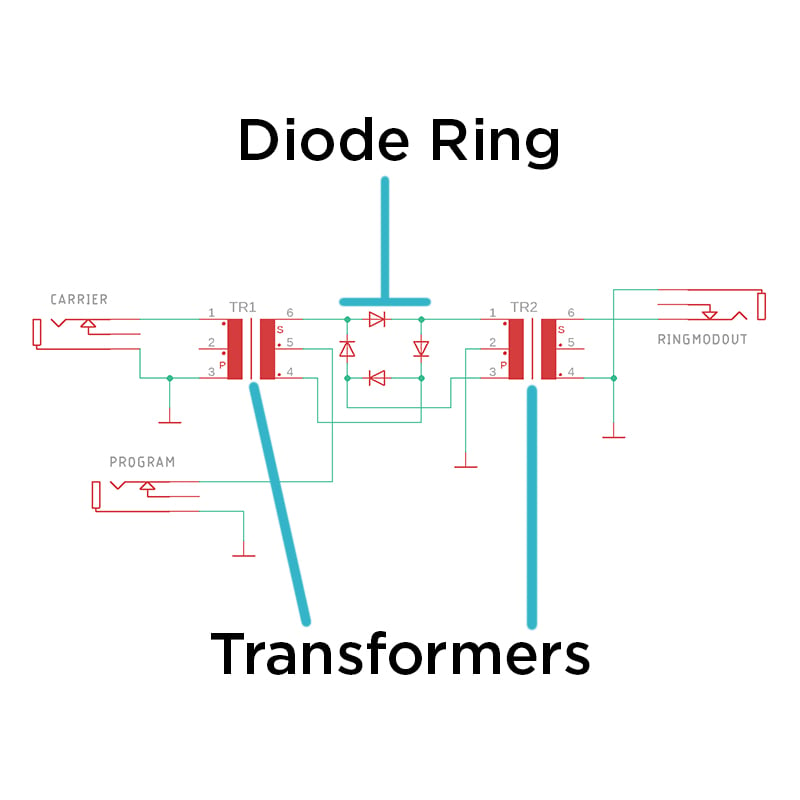
The term "ring" in ring modulation simply comes from the ring of diodes found in the earliest implementation of the ring modulator. A pair of transformers and a ring of diodes performs the signal multiplication process. While many devices still bear the name or description of ring modulator, they do not use that characteristic circuit implementation.
Ring modulators, like any analog circuit, include some inherent imperfections; and as such, some ring modulators may let a portion of the carrier signal pass even without the program signal present. A solution for this problem lies in a feature often called Squelch. A squelch circuit involves an envelope follower tracking the loudness of the program signal, and using the derived envelope to control the loudness of the ring modulator's output (via VCA). This way, the ring mod is only audible when the program signal is active—leaving carrier bleed and noise on the program input gated in moments of near-silence. Most standalone ring modulators feature an internal squelch circuit, while others, particularly modular ring modulators, require external patching to create this behavior.
As an aside—the terms "balanced modulator" or "four-quadrant multiplication" come up as synonyms for ring modulation quite often. They are related, yes, but not exactly the same thing. A balanced modulator typically features a modulation index control which goes from traditional VCA behavior with no carrier rejection and increases carrier rejection as the index increases. With the fully balanced modulator at the point of maximum carrier rejection, it acts essentially as a ring modulator. A bipolar VCA allows for both positive and negative amplification of a signal. Negative amplification inverts the phase of the signal, folding it over on itself and transforming the harmonic structure—a result identical to the fundamental behaviors of ring modulation.
Where Did Ring Modulators Come From?
The ring modulator was invented by Frank A. Cowan of Bell Labs in 1934 and patented in 1935. The original intention of the ring modulator was frequency-division multiplexing, allowing a telephone cable to transmit multiple voice signals.
Ring modulation as a tool for music traces its roots to some of the earliest experiments in electronic music—famously including the work of Louis and Bebe Barron. Louis built primitive circuits, and Bebe performed on them. These early circuits combined tube relaxation oscillators and diode ring modulators with other fairly simplistic designs by today’s standards. Interestingly, most or all of the Barrons' circuits came with a limited lifespan. They thought of the circuits not in traditional synthesizer terms (after all, synthesizers hadn't yet been invented), but as organisms going through a lifecycle. The tubes used in the oscillators often expected an input voltage of 1V or 2V, but Louis charged them up with 300V, so...no wonder they had a short lifespan. The stress on the oscillators in conjunction with the ring modulators produced wild and inorganic tones, unheard by the general public up until then.
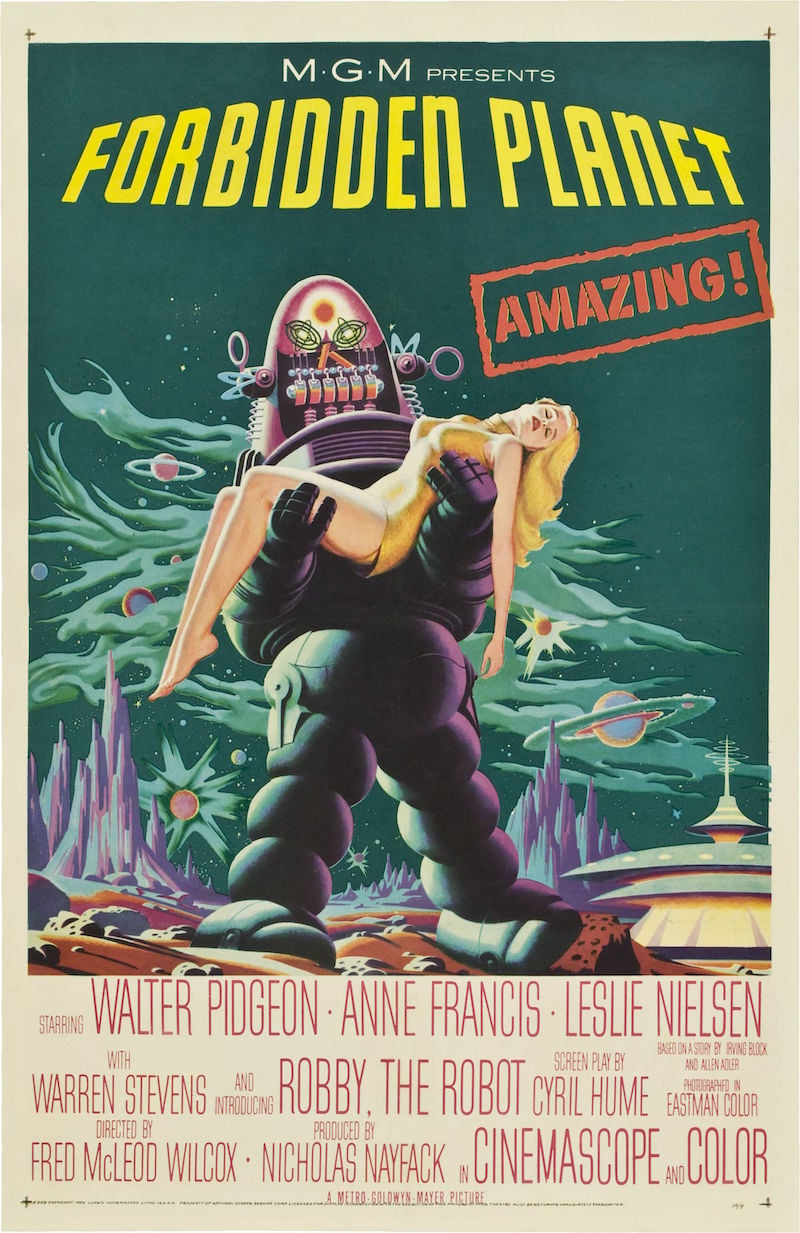
Their most well-known project was the groundbreaking soundtrack to 1956 film Forbidden Planet. Although initially only tasked with creating sound effects, the studio decided to go all out with the first-ever electronic music score. Louis designed a series of sound generation circuits, each with its own unique voice, suited to a particular theme or motif. The soundtrack took eight months to compose, record, splice the tape, rerecord, and master to achieve the final result. In the end, the Musicians Union ruled that they were not musicians and credited them simply as "Electronic Tonalities." Due to this fact, the Academy Awards completely overlooked them. The Barrons never scored another movie.
Ring modulation was also a staple in other early tape and electronic music studios. The Studio for Electronic Music (WDR) collected a number of laboratory equipment for use with sounds recorded to tape. Karlheinz Stockhausen, for instance, produced many works inextricably linked to ring modulation. In his piece Mixtur for orchestra, four sine-wave generators, and four ring modulators, microphones pick up the sounds of an orchestra, which then run to the ring modulators (using the sine wave generators as carriers). This piece famously took the traditional role of the orchestra and added new textures, timbral shifts, microtonal pitch changes, and even rhythmic movement...all from a few simple ring mods and oscillators.
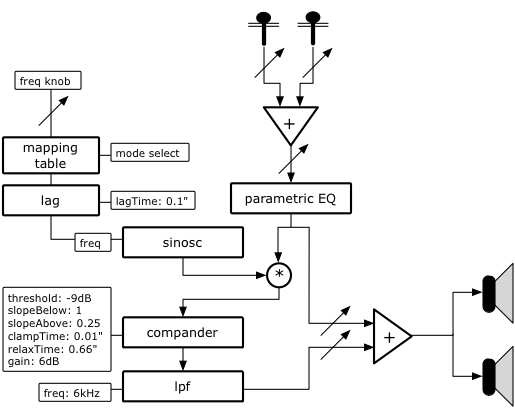 Processing signal flow for Mantra, via staff.city.ac.uk
Processing signal flow for Mantra, via staff.city.ac.uk
For Stockhausen’s Mantra (1970), the composer commissioned a specialized device to realize the piece. The device, called the MODUL 69 B, featured microphone preamps, bandpass filtering, beat-frequency oscillators, amplitude modulation, and most relevant to this article, a ring modulator. For this piece, Stockhausen selected the oscillator frequencies based on the tuning of the pianos. As the pianos play, an operator follows and tunes the oscillator to the necessary frequencies—creating everything from classic ring mod dive bombs to subtle, shimmering textures.
Also worth note—the BBC developed one of its sound effects departments, the Radiophonic Workshop, in 1958. As it grew and developed, it became one of the cutting-edge facilities for music technology and electronic music, with members including Daphne Orham, Delia Derbyshire, and Desmond Briscoe. Much of the work produced, particularly in the early days, was directly influenced by experimental tape music. The unique sounds created in the workshop helped bring new life to the programs and introduce the general public to new ways of generating sounds. They worked closely with the popular program Dr. Who, providing everything from the theme music to the sound of the TARDIS dematerializing. The iconic and inhuman voice of the Daleks comes from an actor speaking into a ring modulator. Even if you’ve never seen an episode of Dr. Who, the sight and sound of the ferocious Dalek strikes fear into the heart. Exterminate! (Check out this rad video from the BBC of voice actor Nicholas Briggs explaining how he creates the sound of Dalek voices using a Moog MF-102 ring modulator in the modern Dr. Who series!)
Ring Modulators as Musical Instruments
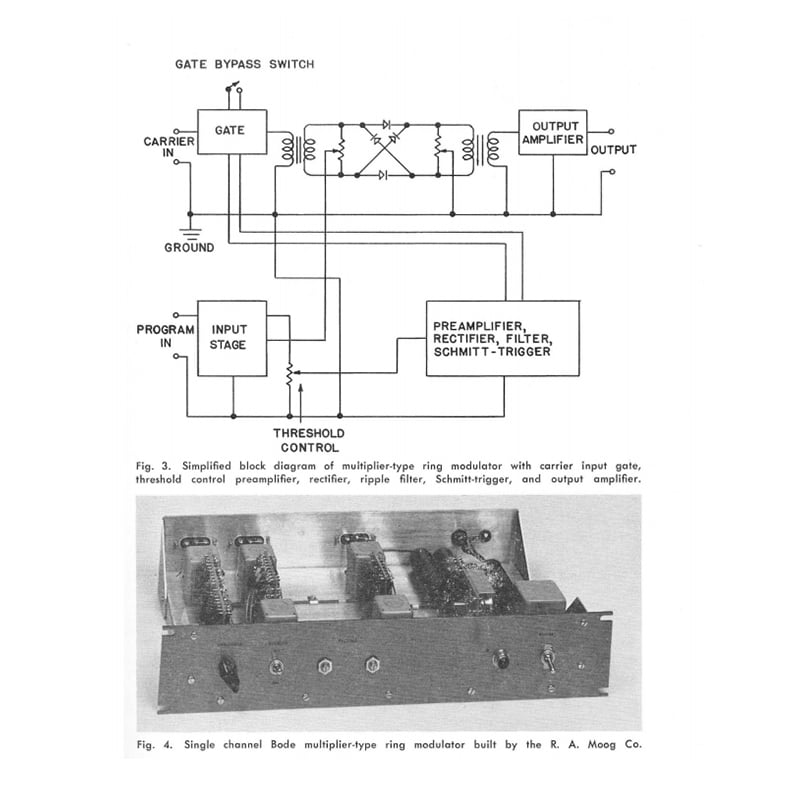 Moog's Bode-style ring modulator
Moog's Bode-style ring modulator
Harald Bode developed perhaps the first ring modulator for intended specifically for musical purposes in 1961. The design uses the classic transformer/diode ring construction but adds a few quality of life features. Most notably, this implementation added the aforementioned squelch circuit, ensuring that the ring modulator only pass audio when the program input is active—now a fairly typical feature in standalone ring modulators. Additionally, the inclusion of potentiometers in the transformer path helps fine-tune the balance and characteristics of the ring modulation. However, Bode is better known for his work with the Bode Frequency Shifter, a device not dissimilar to a ring modulator, which we discuss more extensively in our Weird FX article on frequency shifters.
Because of their emergence from the world of academic electronic music, the development of modular synthesizers included ring modulators, even in their earliest stages. Moog's original instruments include Bode-derived ring modulators, and the Buchla 100 series included the 111 Ring Modulator: two independent ring mods, each two outputs. The later Model 285 Frequency Shifter/Balanced Modulator, as the name suggests, features both a frequency shifter and a balanced modulator behind a single panel. The voltage-controlled balanced modulator features continuous control from unmodified to amplitude-modulated and ring-modulated signals. Again, we'll talk more about frequency shifters in this article.

Ring modulators also showed up in the first semi-modular synthesizers, a fact which we interpret as meaning that ring modulation was still considered a critical electronic music studio technique in the early 1970s. The ARP 2600 included a ring modulator in its normalled signal path (image above taken from the ARP 2600 user manual). By default, the normalled connections come from VCO1's sawtooth and VCO 2's sine wave. However, the ring modulator sits directly below the preamplifier circuit, just begging to ring mod your voice or acoustic instrument (as Ben Burtt did when designing the sounds of R2-D2 for Star Wars). As synthesizers have evolved, ring modulators have remained a fairly standard part of their signal architecture—even in fixed-architecture instruments. In instruments as early as ARP's Odyssey and onward to modern virtual analog synthesizers, for instance, it's fairly typical to see the ring modulator alongside oscillators and noise as a pre-filter signal source...usually with internally normalled connections to two oscillators, as we described in the 2600. Some modern virtual analog synths, such as ASM's Hydrasynth, even allow you to disable the ring mod's connection to its internal oscillators in order to ring modulate external sounds.
Perhaps the first device that resembles a modern pedal ring modulator came from Tom Oberheim, under the Maestro brand name. It features a microphone preamp, sine wave oscillator, and balanced modulator. The oscillator acts as the carrier, and the external input allows for a wide range of program material. In addition to the internal oscillator, a carrier input allows for an external oscillator or secondary instrument to override the internal oscillator. A pair of performance foot pedal inputs gives users control over the blend of the dry and ring modded signals and the oscillator frequency. The included squelch circuit uses an LED and light-dependent resistor (aka vactrol) to generate the linear squelch. This both suppresses the carrier oscillator’s bleed through while also reducing the noise of the program signal.
One of the best-known ring modulators is the Moogerfooger MF-102 Ring Modulator, introduced by Bob Moog's Big Briar at the turn of the millennium (and regrettably discontinued in the past few years). This pedal-format ring modulator includes an internal sine VCO carrier with two frequency ranges. The drive control sets the amplitude of the incoming program signal, ranging from below line-level to modular level, and a mix control allows you to introduce some of the program signal back in with the ring modulated signal. All parameters except for the drive include a dedicated input for use with an expression pedal or external control voltage. In addition, an input for an external carrier signal disconnects the internal carrier VCO, allowing you to ring modulate any two sounds you desire.
Interestingly, the MF-102 also includes a built-in modulation oscillator intended to modulate the pitch of the internal carrier, great for jarring trills and odd frequency sweeps that sound vaguely like you're decoding an alien broadcast. Additionally, dedicated outputs also allow for the carrier and LFO to modulate other parameters in your setup. With this kind of flexibility, it's no wonder that this pedal has become a modern classic—and in many ways, the de facto standard for what a standalone ring modulator should be like.
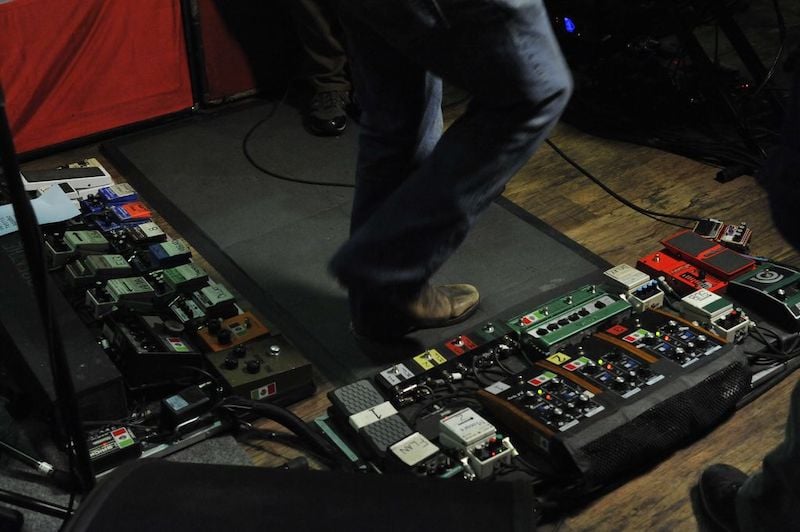 Former live pedal rig of bassist Juan Alderete for The Mars Volta—featuring not one, but THREE Moog MF-102 Ring Modulators. Whoa. Juan Alderete, you rock.
Former live pedal rig of bassist Juan Alderete for The Mars Volta—featuring not one, but THREE Moog MF-102 Ring Modulators. Whoa. Juan Alderete, you rock.
As a side note, the LFO-modulated ring mod effect can be heard all over the Mars Volta's music, specifically utilizing the Moog MF-102. Once you notice it, you'll start to hear this effect on everything from drums and bass to vocals. For instance, check out the opening riff of "Roulette Dares (The Haunt Of)" from 2003's De-Loused in the Comatorium for a very clear example on guitar, and the chorus of the acoustic version of "The Widow" from the Frances the Mute single for a not-so-subtle example on vocals. Another interesting, but more subtle example—starting around 8:20 in "Tetragrammaton" from 2006's Amputechture, alternating vocal phrases are processed via ring modulator with the carrier subtly modulated via square wave. You'll notice the first vocal phrase in this section is completely dry, but the subsequent phrase has this odd, uncanny robotic quality—and this section is a conversation between these two vocal characters. This is a great example of ring modulation at work.
So...How Do You Use a Ring Modulator? Tips + Tricks
Alright, so we know the technical details about how a ring mod works...but like...what is it for? For many musicians, practical uses may not be obvious—in fact, they became ubiquitous in early experimental electronic music studios largely because they could create sounds so unlike the timbres of traditional instruments. They provided great promise for the creation of foreign soundscapes and textures. As it turns out, altering the harmonic content of sound in such a drastic way has the capacity to turn almost any sound into something much more complex, rich, and mechanical. Of course, we're not all likely to build our own death-bound electronic organisms, or to ring modulate a live orchestra—so how could we use a ring modulator?
 Original advert for the Electro Harmonix Frequency Analyzer, which seems to imply that ring modulation is similar to pitch shifting—which...it really isn't
Original advert for the Electro Harmonix Frequency Analyzer, which seems to imply that ring modulation is similar to pitch shifting—which...it really isn't
Often, the examples you see when discussing ring modulators only use examples of sine waves. This is due to the fact that sine waves only contain a single fundamental frequency and no overtones or harmonics, which makes the concept much easier to explain. Multiplying two sine waves gives only the sum and difference of the single frequency component. But this only really holds true for sine waves, as overtones in more complex waveforms won’t translate to a perfect frequency ratio. When ring-modding waveforms with more complex harmonic structures—such as other synth waveforms or acoustic instruments, the result mirrors this complexity. As such, using a sine wave as the carrier waveform became fairly standard very early on. While the ring modulators in early electronic music studios and modular systems required an external carrier, it soon became so common to use a sine oscillator as carrier that, starting in the early 1970s, some manufacturers began building standalone ring modulators that included an internal oscillator—that's the case with the Maestro ring mod, the Electro Harmonix Frequency Analyzer (curiously, originally marketed as a way to make your guitar sound like it was 19 feet long?), and the Moog MF-102 described above.
These days, most standalone ring modulators follow this same formula—they usually include a built-in oscillator, which most commonly has only a sine waveshape (though there are definitely exceptions). Of course, the most classic "ring mod" sounds just involves directly ring modulating acoustic sound sources with an oscillator. This can create everything from very odd, inharmonic sounds to very brittle, pseudo-bitcrushed sounds, as heard in our example toward the beginning of this article—it's great as an aggressive and peculiar-sounding alternative to distortion, a great way to add edge to sounds. Ring modulating more complex sounds—like noise, snares, or other percussion—can also add everything from subtle coloration to extreme shifts, or even the introduction of tonal reinforcements to otherwise unpitched sounds. Add ring modulation to a kick drum or snare and things get gnarly really quickly. But there are definitely other tricks you can use to get more predictably tonal results out of your ring modulator as well!
A quick and easy hack—try tuning your ring modulator's oscillator to the root note of the song you're playing in. This will make it such that when you play relatively consonant notes—the root note, fourth scale degree, or fifth scale degree, for instance—the sum and difference tones will be very clearly harmonically related to the note you're playing. This can create interesting harmonies and timbral reinforcements.
It's perhaps worth mentioning again that in most fixed-architecture synthesizers that include a ring modulator, the ring mod is by default connected to two of the oscillators, each of which track the same keyboard but can be offset from one another's pitches by some user-definable interval. This is because of the same phenomenon we just described—if you can ensure that the two sounds that are being ring modulated together for a relatively clean musical interval (octaves, fifths, fourths, etc), then you can ensure that the result will be a stable, clean sonority. Moreover, even if you've dialed in a dissonant interval between your oscillators, this still works fine—the result will be more clangorous, but if both the carrier and modulator can be made to track one another, this works quite well.
Of course, that's a bit harder to pull off in the acoustic world—unless you have a nice guitar synth or similar audio-to-CV/MIDI device, it might be difficult to get your ring modulator to track your current pitch, and as such, it might be difficult to get it to produce consistently "musical" sounds. But happily, as with most things, there are workarounds. For instance, if you're a guitarist trying to "hack" more musical ring mod sounds (and if your ring mod has the option to bypass the internal oscillator), you could split your guitar's signal, run one output into the ring mod's carrier input, and run the second output through a pitch shifter and then into the ring mod's modulator input—effectively ring modulating your instrument's dry and pitch shifted signals together. If you dial in a consonant pitch shift amount (octaves, fifths, etc.) then you should be able to create some relatively stable but very distorted-sounding tones unlike any other fuzz or distortion out there.
If you don't have a pitch shifter, you could even just run the guitar signal itself into both the carrier and modulator inputs. Hypothetically, as mentioned above, this should create a pseudo-octave-up effect, given that the sum of all the frequencies should be double the input frequency and the difference should be 0Hz (silence)...however, the reality is that this usually creates a peculiar form of distortion/pseudo-pitch-shift that just sounds outright nasty. You could also experiment with using similar techniques to ring modulate two instruments together—so maybe grab a friend and try playing in unison or playing harmonies to see what kind of bizarre sounds you can come up with.
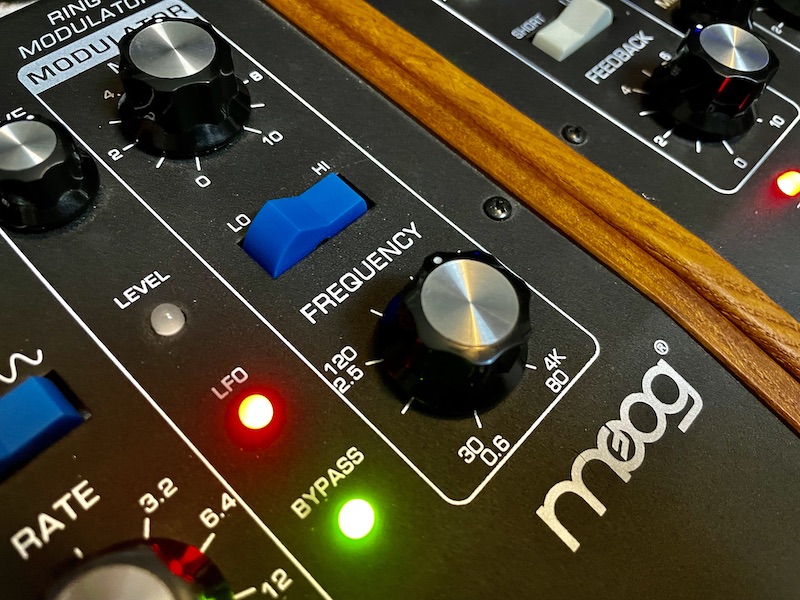 Frequency range switch detail on the Moog MF-102
Frequency range switch detail on the Moog MF-102
Another thing worth noting: it's common these days for ring mods with built-in oscillators to include the option for a "low frequency" mode (as in the Maestro, the Moog MF-102, Fairfield Randy's Revenge, and others). Using a low-frequency oscillator basically multiplies the external signal's amplitude with a slowly changing value, resulting in a tremolo-like effect. Now, this usually won't have the exact characteristics of a traditional VCA-based tremolo. Many ring modulators may introduce a slight distortion or coloration when used with low-frequency content.
Another interesting and peculiar way to use a ring modulator involves using a carrier sine wave and a program noise source. Let’s say we have a sine wave at 1000Hz (1kHz) and a band-limited noise source that includes an equal frequency distribution between 100-200Hz. This ring modulator’s output is two sets of bandlimited noise with equal distribution at 800–900Hz and 1100–1200Hz. As we alluded to before, techniques like this can be a great way to create more peculiar and nuanced textures and percussion sounds; a little bit of experimentation can go a long way.
Modern Eurorack Ring Modulators
The Make Noise Moddemix is a two-channel balanced modulator with mixing capabilities. While not a dedicated ring modulator and more of a balanced modulator, the Moddemix allows for a broad range of functionality. It includes two identical channels with program and carrier inputs, plus an aux input. The module cascades the input signal present at the first input into the second with no cable present and mixes the two channels available at the SUM output. One trick to reintroduce the program signal back in with the ring modded signal is to take advantage of the normalization. With a single cable patched into the program inputs, the signal passes into both the top and bottom modulators. Applying a carrier waveform to the bottom modulator introduces ring modulation only on that channel, letting you mix in the top channel with the final product. Using the Moddemix as a more standard VCA introduces a distinctive, but not overpowering, distortion to the program signal.
In 2017, Serge Tcherepnin redesigned the classic Serge ring modulator in collaboration with Random*Source. Serge added a number of quality of life improvements that bring the RING to the next level. Compared to many other ring modulators, the signal path remains remarkably clean, even at low signal levels where other ring modulators introduce distortion. The whopping 80dB of carrier rejection ensures no leakage or coloration from the carrier signal. Due to the extreme carrier signal rejection and low-noise performance, the design omits a squelch circuit.
The index ranges from the untreated input signal to amplitude modulation and finally ring modulation. A dedicated CV input blends from the unmodulated program signal to a fully balanced and ring-modulated multiplication of the carrier and program. This CV input also allows for more traditional amplitude modulation effects using a unipolar envelope. Turning the carrier input potentiometer above the center position rounds out the edges of the waveform, providing another level of timbral shaping.
The IO Instruments Pasiphae Ring Modulator includes both AC-coupled and DC-coupled inputs for the X and Y inputs (program and carrier). The combination of coupled inputs brings additional functionality to the ring modulation, even the ability to ring modulate four signals against each other. Both DC-coupled inputs feature an offset control to offset the signal above or below 0V. Each input also features a dedicated input attenuator to blend the sources. Both the X and Y channels feature muting functionality, both on a manual button and an external gate input. The module splits the ring modded signal into both positive and negative signals with dedicated outputs for each.
While not ring modulation in the traditional sense, many synthesizer manufacturers have resorted to implementations of logic-based pseudo ring modulation. These boolean logic ring modulators give a rough approximation of a ring modulator but achieve it completely differently. For more information on logic, please see this article.
The AJH Entropic Doom is a holistic noise oscillator, or noisillator, that packs a unique logic-based noise generator with a low pass filter, CMOS gate VCA, and an XOR ring modulator. Instead of the traditional method of creating noise with a polarized component, the module uses a specially configured logic gate, biased for use in the continuous analog space that exists between logic 0 and 1. This configuration allows users to tune the noise to a specific range of frequencies and sync it to another source, much like an oscillator.
In addition to the logic-based noscillator, it features an XOR logic ring modulator. XOR logic outputs a high signal when one input or the other is active and outputs a low signal when both or neither are active. Another way to think about it, the output is inactive when the two inputs match and active when they do not match. Due to this fact, the XOR ring modulator doesn’t require two active signals to output a signal. The output, like most logic modules, is a pulse waveform. The module does not feature an internal normalization from the Noiscillator, requiring a manual patch cable in order to connect them, a process commonly referred to as patch programming.
Similarly, Blue Lantern looked to the ARP Odyssey for inspiration for the CMOS Ring Mod but added a few things to make it their own. The design uses NAND gate logic to achieve the ring modulation. A NAND logic gate is a two-input boolean logic gate whose output remains high unless both inputs are active. A smoothing circuit post logic circuit turns the rough pulse waveforms into triangle waves. The inputs on the CMOS Ring Modulator also include thru outputs, removing the need for multiples or stacking cables to route them to more than one destination or mix in with the ring modulator.
Need other recommendations? Check out our full selection of Eurorack format ring modulators!
Modern Pedal Ring Modulators
The Fairfield Circuitry Randy’s Revenge is a no-nonsense (but still fully-featured) all-analog ring modulator with an approachable feel. It features a sine/square oscillator with two frequency ranges, allowing for everything from choppy square tremolo to smooth sine swells all the way into edgy classic ring mod tones. A low pass filter smooths out the rougher edges of the ring mod effect. Use the dry/wet mix and output volume to adjust the feel of the pedal to hit the rest of your FX chain just the way you need.
That's the surface of Randy's Revenge: simple and straightforward. I'd go so far as to say that it sounds every bit as good as Moog's MF-102 (which is high praise from a ring mod nerd), but it does lack the Moog's internal LFO and extensive expression/control voltage connectivity. However, Randy's Revenge isn't without its tricks: a configurable expression pedal/CV input provides external control over the carrier oscillator frequency or low pass filter frequency. Inside the pedal, a series of mini-switches allow for greater control over the functionality, letting you tailor the CV jack to your needs. In addition to switching between CV and expression pedal modes, one switch mode even outputs the carrier oscillator on one part of a TRS cable, allowing you to route it to other devices in your pedalboard or synth setup.
Or, if you want to get a bit gnarlier, the Electro-Faustus EF116 Infektor takes the already esoteric behavior of ring modulation and takes it to the next level. It features a fairly simple control set—offering only a single frequency control for its internal carrier: no wet/dry mix in sight. Once you've stomped it into its engaged position, you're accessing full-on, grimy, noisy ring modulation. Infektor also features a built-in lowpass filter with continuously variable frequency and resonance. In some ways, this is a timbral courtesy: ring mod pedals often include a lowpass filter in order to tame some of the harsh upper sidebands, which can be a bit too jarring or piercing from some musical applications. However, the filter here can also be a source of its own character: by turning up the resonance, the filter becomes a tool for strongly accentuating specific spectral regions. So sure, you can use the filter to tame the Infektor's sound...or alternatively, you can use it to bring focus to the already harsh and clangorous tones that ring modulation provides.
Of course, ring modulation is a feature of many other pedals as well—the Dr. Scientist Bitquest and Alexander Syntax Error 2 each feature a ring modulation mode, as do many multi-effect pedals and guitar synth pedals. As with most effect types, there are far too many out there to cover extensively...but these are a few of our favorites.
Need other ideas? Check out our full selection of ring mod pedals!
Ringing Things Up
While ring modulation provides a type of amplitude modulation, the results and methodology vary drastically from a traditional VCA. By extracting the sum and difference of two signals, you end up with radically new sounds and timbres. Happily, ring modulation isn't like more conventional effects like distortion, delay, or fuzz—because it's so peculiar, it still feels like it offers plenty of ground for plotting completely new sonic explorations. No doubt there are still plenty of exciting uses that we haven't dreamed up.
And of course, the story of ring modulation doesn't end there at all. As we’ve touched on a few times, ring modulation is closely related to frequency shifting and share several key elements. The follow-up to this article expands on the concept of frequency shifting and delves deeper into its history and the countless weird sounds it can produce.

